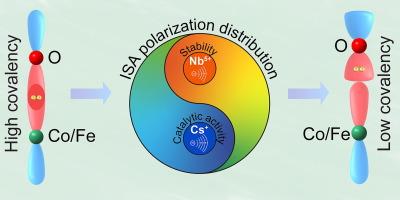采用离子路易斯酸强度极化分布策略设计双陶瓷电池空气电极
IF 14.9
1区 化学
Q1 Energy
引用次数: 0
摘要
陶瓷电池有望成为理想的能量转换和存储设备,因此开发高效、坚固的空气电极对其应用至关重要。本研究采用钙钛矿a - b位离子刘易斯酸强度(ISA)极化分布策略,设计了Ba0.4Sr0.5Cs0.1Co0.7Fe0.2Nb0.1O3−δ (BSCCFN)空气电极,并成功应用于氧离子导电固体氧化物燃料电池(O-SOFCs)和质子导电可逆质子陶瓷电池(R-PCCs)。当BSCCFN用作空气电极在O-SOFCs,峰值功率密度(产后抑郁症)的1.45 W厘米−2是达到650°C,而在R-PCCs,产后抑郁症的1.13 W厘米−2−−1.8厘米2的电流密度在1.3 V实现在同一温度和显示稳定的可逆性超过100 h。实验测量和理论计算证明low-ISA Cs +掺杂加速氧离子和质子的反应动力学,而high-ISA Nb5 +掺杂提高电极稳定性。Cs+和Nb5+共掺杂在BSCCFN电极中的协同作用在于ISA极化分布,减弱Co/ Fe-O键共价,从而促进氧空位的形成,促进氧离子和质子的传导。本文章由计算机程序翻译,如有差异,请以英文原文为准。

Designing an air electrode for dual ceramic cells using an ionic Lewis acid strength polarization distribution strategy
Ceramic cells promise ideal energy conversion and storage devices, making the development of efficient and robust air electrodes crucial for their application. In this study, a Ba0.4Sr0.5Cs0.1Co0.7Fe0.2Nb0.1O3−δ (BSCCFN) air electrode, based on Ba0.5Sr0.5Co0.8Fe0.2O3−δ (BSCF), is designed using a perovskite A-B-site ionic Lewis acid strength (ISA) polarization distribution strategy and is successfully applied in both oxygen-ion conducting solid oxide fuel cells (O-SOFCs) and proton-conducting reversible protonic ceramic cells (R-PCCs). When BSCCFN is used as the air electrode in O-SOFCs, a peak power density (PPD) of 1.45 W cm−2 is achieved at 650 °C, whereas in R-PCCs, a PPD of 1.13 W cm−2 and a current density of −1.8 A cm−2 at 1.3 V are achieved at the same temperature and show stable reversibility over 100 h. Experimental measurements and theoretical calculations demonstrate that low-ISA Cs+ doping accelerates the reaction kinetics of both oxygen ions and protons, while high-ISA Nb5+ doping enhances electrode stability. The synergistic effect of Cs+ and Nb5+ co-doping in the BSCCFN electrode lies in the ISA polarization distribution, which weakens the Co/Fe–O bond covalency, thereby promoting oxygen vacancy formation and facilitating the conduction of oxygen ions and protons.
求助全文
通过发布文献求助,成功后即可免费获取论文全文。
去求助
来源期刊

Journal of Energy Chemistry
CHEMISTRY, APPLIED-CHEMISTRY, PHYSICAL
CiteScore
19.10
自引率
8.40%
发文量
3631
审稿时长
15 days
期刊介绍:
The Journal of Energy Chemistry, the official publication of Science Press and the Dalian Institute of Chemical Physics, Chinese Academy of Sciences, serves as a platform for reporting creative research and innovative applications in energy chemistry. It mainly reports on creative researches and innovative applications of chemical conversions of fossil energy, carbon dioxide, electrochemical energy and hydrogen energy, as well as the conversions of biomass and solar energy related with chemical issues to promote academic exchanges in the field of energy chemistry and to accelerate the exploration, research and development of energy science and technologies.
This journal focuses on original research papers covering various topics within energy chemistry worldwide, including:
Optimized utilization of fossil energy
Hydrogen energy
Conversion and storage of electrochemical energy
Capture, storage, and chemical conversion of carbon dioxide
Materials and nanotechnologies for energy conversion and storage
Chemistry in biomass conversion
Chemistry in the utilization of solar energy
 求助内容:
求助内容: 应助结果提醒方式:
应助结果提醒方式:


